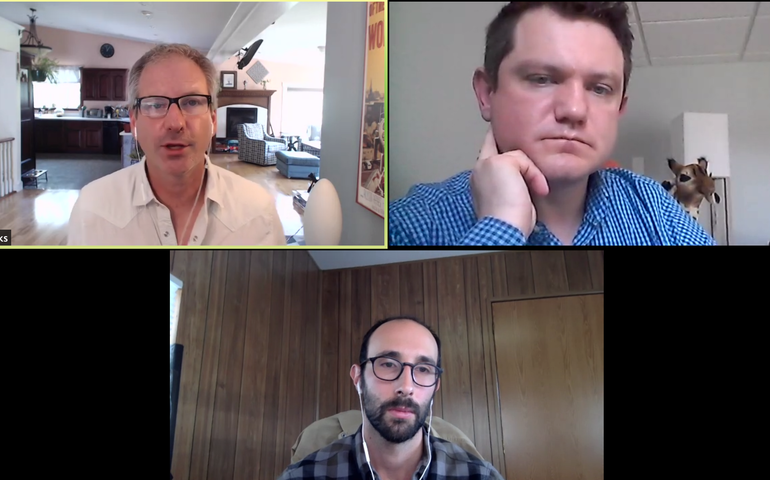The pandemic drove Maine businesses to e-commerce. Will they stay there?
 Screenshot
Rich Brooks of flyte new media, top left, and Cameron DeLeone of Common Wealth Poultry Co., bottom, discussed e-commerce strategies during the pandemic, in a webinar moderated by Opus Consulting Group’s Andrew Wood.
Screenshot
Rich Brooks of flyte new media, top left, and Cameron DeLeone of Common Wealth Poultry Co., bottom, discussed e-commerce strategies during the pandemic, in a webinar moderated by Opus Consulting Group’s Andrew Wood.
As the Maine economy spiraled into a major downturn, some businesses navigated their way into new or expanded e-commerce strategies and a broader digital presence overall.
The question is, will the shift endure past the pandemic?
The answer, in part, depends on how deeply entrenched the shift has become in consumer habits.
“I think companies recognize that consumer behaviors have shifted,” said Rich Brooks, president of flyte new media, a Portland web design and digital marketing agency.
With the pandemic, he said, more companies have invested in more-robust websites that cater to consumers online rather than face-to-face interactions. “We’re seeing that across different industries,” he added.
Brooks was one of two panelists speaking in a webinar on Wednesday about how to develop an “e-strategy” for a post-pandemic world. Hosted by Portland’s Opus Consulting Group and moderated by one of the group’s consultants, Andrew Wood, the webinar focused on changes businesses have implemented in their digital strategies post-lockdown.
Wood said certain retail sectors have doubled sales through e-channels.
Brooks said many of flyte’s clients have been taking their digital presence more seriously and spending more time to enhance their websites and develop other digital strategies during the pandemic.
“The companies that are going to be winning now and into the future are the companies that are investing more in their online presence,” he predicted.
A number of clients, he added, are looking for ways to add more functionality and visibility to their platforms. In tandem, consumers are getting trained into behaviors to use e-commerce options — and that could stick around long after the pandemic, he said.
For example, he said, consumers are becoming comfortable with options like delivery from smaller stores, while previously many had viewed delivery as a service coming from retail giants like Amazon.
Online poultry sales
Common Wealth Poultry Co. is an example of a company that launched an e-commerce business in just a couple of weeks.
Ryan Wilson and Gina Simmons started Common Wealth in Gardiner in 2010 and today wholesale hundreds of thousands of chickens and other poultry.
Late last year, Wilson and his new digital marketer, Cameron DeLeone, began talking about how to leverage digital media to grow the business. When the pandemic hit, said DeLeone, they realized they had to pivot to online direct-to-consumer sales. In about three weeks, DeLeone had set up an e-commerce store with high-end photography to show the company’s goods.
“We saw this as an opportunity,” he said, since more consumers were looking for locally grown food. “It was pretty clear that delivery would win the day.”
Many consumers are accustomed to ordering food online, but it generally comes to them frozen, he said.
“Our opportunity is be able to ship fresh product,” he continued.
Sales shot up in early April.
“By mid- to late May, we were doing hundreds and hundreds of orders per week,” he said.
The company rolled out social media advertising, which resulted on a good return on their investment in the next two months, he said.
By June, though, sales began to plateau.
“We hit a point where we started to hit diminishing returns,” he said. “Now we’ll step back and, over the coming months, we’ll flesh out our content strategy more.”
Still, he added, “We looked at this as opportunity get people in the door,” get them familiar with the products and get them buying over the internet, he said.
At the same time, he said, the company used the opportunity to develop and test a subscription service for its products. The service launched mid-May with three boxes of various products. Now the service offers pre-built or customized boxes. Offered at a discount, the service is a good source of predictable revenue, he said. Common Wealth now has about 75 customers with standing orders.
“It’s a relatively modest number of people, but it’s proof of concept,” he said. “We’ll prioritize that going forward” on the retail side of the business.
Noting that there’s no “one size fits all” digital strategy, Brooks said it’s important for companies that are experimenting with e-commerce to figure out what their messaging is and how to communicate how they serve consumers.
“Pay close attention to the tone of your audience and what they’re looking for from you, and be ready to shift your messaging,” he said.
Small proprietors in particular, he said, have a message about being local and family-owned.
“You have to build that loyalty from your product and from your message,” he said. “There’s a percentage of people interested in supporting small and family businesses.” Messaging local and family ownership, he said, is important.
What’s the biggest mistake involved in launching an e-commerce strategy?
“Not having a strategy,” said Brooks. “It’s not one of those ‘if you build it they will come’ situations.”
Companies that have never offered e-commerce, he added, can find platforms that are easy to set up; some businesses might be looking to just set up an order form on a website, others might be looking for more expensive solutions. Also key, however, is not to spend the entire digital budget on the platform itself. Investment is also needed in online marketing, he said, in order to drive traffic to the site.
“It’s about pivoting right now,” Brooks continued. “Right now, things are changing day-to-day. It’s important to listen to what your audience needs.”










0 Comments